Catharanthus: Cultivation, Reproduction, Care
Catharanthus is a beautiful shrub dotted with flowers that will fit perfectly into any home. The name of the plant is translated from Greek as “clear, flawless flower”. Many experts believe that the catharanthus is the most spectacular ornamental shrub existing today. Its flowering continues almost all year round. The plant is distinguished by its unpretentiousness in care; it has been cultivated at home since the 18th century. The indoor catharanthus has not yet managed to gain great popularity among gardeners, which is a pity. There are quite a few such flowers in Kyiv, but they will definitely take their rightful place in the collection of domesticated cultures.
Catharanthus in Depth
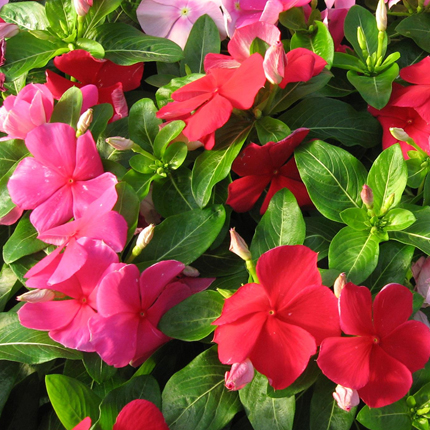
The catharanthus flowering shrub is a member of the Apocynaceae family. The genus is represented by herbaceous plants and shrubs. Under natural conditions, it grows mainly in tropical forests. The highest concentration is represented on Java, in Indochina and Indonesia. Madagascar is considered the birthplace of the plant, where 8 species of shrubs are represented. The plant grows up to 150 cm (~4.9 ft.) in height in a natural setting, while the decorative species reach a mark of 70 cm (~2.3 ft.). For a long time, experts considered the catharanthus a kind of periwinkle, and only 100 years ago they began to classify it separately. The first separate subspecies was the pink catharanthus (Catharanthus roseus) in 1937.
By its nature, the semi-shrub is perennial, but it is grown at home as an annual plant. The fleshy shoots often branch and wooden over time. The root system is quite powerful, growing in the form of a rod. It deepens into the ground by 20-30 cm (~7.9-11.8 in.) and has a large number of lateral appendages with a pungent odor. The root hairs are absent in young appendages. The leaf plates with points on both sides reach 7 cm (~2.8 in.) in length. The dark green shiny leaves are adorned with a white vein in the center. The wheel-shaped flowers cover the entire surface of the shoots. They reach 50 mm (~2 in.) in diameter and consist of 5 petals with a flat corolla. There is a contrasting eye in the core of the flower. The breeders have bred many species with lilac, white, and purple flowers. The flowering ends with the onset of the first frost. Fruits are formed in place of flowers – the crescent-shaped double-leaves. Inside each, there are 10 elongated seeds with high germination. In addition to its high decorative qualities, the catharanthus possesses universally recognized medicinal properties.
In Indonesia and Madagascar, local healers have long used the plant to treat various ailments. They used it to fight cough, cold, and even tumors. The biologists claim that more than 60 different alkaloids are present in the catharanthus. It can help lower the blood sugar levels for diabetics and those who want to lose weight. The vincristine and vinblastine alkaloids are part of the drugs prescribed for cancer. The decoctions and infusions made from the stems and leaves of the perennial help in the treatment of such complex diseases as:
- Hypertension and diabetes
- Polyps, prostate adenoma, diseases of the urinary system
- Ulcers, wounds, and problems with blood clotting
- Bronchitis, cough, flu, and angina
Under no circumstances should you try to make a drug yourself without special training, as all parts of the plant are poisonous. If you touch the plant with bare hands, burns, allergies, or other side effects may appear on the skin. Folk remedies have serious contraindications, so it is best to consult a doctor first. It is not advisable to give decoctions to children under 14 years old, people with heart disease, and pregnant women.
Types and Varieties
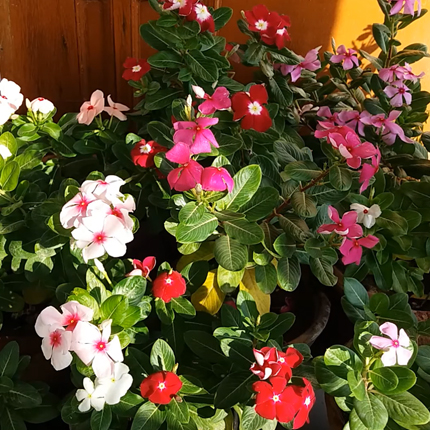
All hybrids known today are descended from the pink catharanthus. They differ in the flower size and shape, petal shade, and bush height. In this article, we list the most popular shrub varieties that are cultivated by gardeners around the world.
Catharanthus Aristocrat
It grows up to 50 cm (~19.7 in.) in height; the flowers are large, up to 5 cm (~2 in.) in diameter. The color of the petals varies from white to dark red. The flowers are large and cover the plant from July to November. The seeds have high germination, and there should be no problems with growing seedlings. The Aristocrat is resistant to drought, and the shrub pot is brought into the house or conservatory for the winter. In landscape design, the plant is used as an ampel or border one. It is easily cultivated in flower beds or containers.
Catharanthus Pacifica
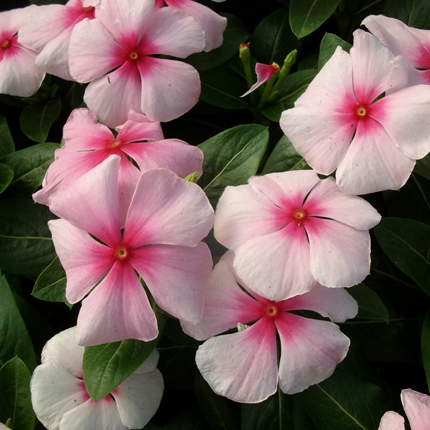
An evergreen perennial, also called periwinkle, it has several unique features such as:
- Early flowering
- Increased branching
- Slight growth
- Excellent resistance to dry conditions
This series has many varieties, among which the Pacifica Polka Dot is considered to be the most famous. It reaches a height of 30 cm (~11.8 in.), and a diameter of 20 cm (~7.9 in.). The leaf plates are dark green. The flowers are white, with a red core, reaching 5 cm (~2 in.) in diameter. The culture blooms actively until the first frost. It tolerates the direct sunlight well, so choose the very center of the site for planting. The plant is transferred to the house or conservatory for the winter.
Сatharanthus Roseus
The most popular type of catharanthus, which has allowed the breeders to develop many hybrids and variety series based on it. The plant has a great resemblance to the common periwinkle, which is why it used to be called the pink or Madagascar periwinkle. The evergreen shrub blooms very profusely. The stem is dense, the leaves are bright green, with a beige vein in the center. The shades of petals vary from cream to burgundy. The shrub takes root well at home, so it is often grown as an ampel plant. Designers use its shoots to decorate vertical structures. The plant’s lashes are extremely decorative and are completely dotted with beautiful flowers. They appear in the axils of the leaves and at the tips of the shoots, reaching 75 cm (~29.5 in.) in length.
Catharanthus Cascade
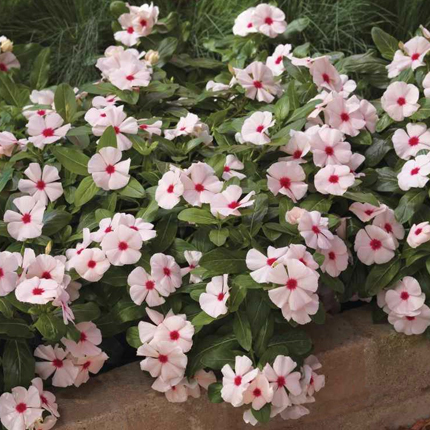
This variety series is represented by a large number of ampel plants, which are so valued among the amateur flower growers. The shrub grows up to 15 cm (~5.9 in.) in length; the shoots hang down and have large flowers. The most popular varieties:
- Mediterranean series: small plants with cute flowers and long shoots. They develop well and quickly fill the pot, easily tolerating drought.
- Cora Cascade F1: compact shrubs, about 40 cm (~15.7 in.) high. The flowers are large, reach 4 cm (~1.6 in.) in diameter, and come in different colors. They show excellent resistance to heat, drought, and direct sunlight. This plant is valued for its unpretentiousness and lush flowering. It grows in a pot for 8-12 weeks, and the decorative effect is extremely high. The variety can be easily found in almost any specialized store.
Catharanthus Tattoo
The Tattoo Black Cherry variety is known to almost every fan of semi-shrubs. The plant has very unusual buds with colors changing from one into another. The petals display a luminescent effect; the shrub is quite dense, and the internodes are short. This plant grows well in dry places.
Heatwave Variety
A dwarf variety of catharanthus; the buds reach 5 cm (~2 in.) in diameter. It is well suited to all fans of ampel flowers as well as flower growing beginners. The plant blooms in the year of planting seeds, provided that you properly care for the shrub. The petals are cherry, white, and purple.
Sicilian Variety
The delicate and very beautiful catharanthus, obtained by hybridization of the pink variety. The lacquered sheet plates have specific crystal veins. The flowers grow delicate and attractive, being very similar to Drummond’s phlox flowers outwardly. The shrub is compact and neat; an adult plant will become a real decoration of any site. The Sicilian variety needs constant sunlight and is usually unable to survive mid-latitude winters.
Growing Catharanthus From Seeds

The catharanthus is easy to grow from seeds even at home. A novice florist will be able to cope with this task. The main condition is to follow a few simple rules and responsibly approach the choice of planting material. The variety of seeds in specialized stores is truly huge, so everyone can find a plant to their liking. The seeds are usually dark brown and quite large in size. The first seedlings can be expected within a week after planting. Start the process in early March – but first, prepare the planting material and choose the right substrate. Specific procedures will help the plant take root faster and create optimal conditions for growth. Many underestimate the importance of the preparatory stage, but this can lead to a regrettable outcome. Special solutions and additives are used to stimulate the seeds. They significantly increase the percentage of germination. The most commonly used materials are:
- Epin (artificially created analogue of natural plant biostimulator). Dilute 3 drops of the product in 100 ml (~3.4 oz.) of water. Then soak the seeds in the solution 3 hours before planting.
- Zircon. Make this solution at the rate of 0.025 ml (~0.00085 oz.) per 100 ml (~3.4 oz.) of water. The seeds are soaked in zircon 4 hours before planting; this product is easy to get and is absolutely safe for plants.
- Succinic acid. It takes about a day to soak the seeds in it. Dilute the solution in the proportion of 1 g per 1 liter of water.
Seeds are also treated in potassium permanganate to prevent the development of infection and protect the seed from possible fungus infection. The solution must be weak so as not to “burn” the seeds; keep them in it for about half an hour. After processing, the seeds are transferred to gauze or a paper napkin and are dried at room temperature. Be sure to choose a large container for planting so that the powerful roots do not become cramped. Good drainage is essential, but make sure the roots do not block the holes. The plant develops surprisingly quickly; you will not even notice how beautiful tropical bushes will start appearing in your garden. Do not rush to plant the seeds immediately in the open ground. The seedlings have good germination, and the preparation is quite simple.
Before planting the seeds for seedlings, it is necessary to prepare the substrate. To do this, mix turf, peat, humus, and leafy soil in the 1:1:1:1 proportions. The novice florists may well get by with a substrate for flowering plants, which can be easily purchased at a specialized store or ordered online. The soil mixture is stratified or treated with a weak solution of potassium permanganate. Grooves are made in the substrate with a depth of no more than 1.5 cm (~0.6 in.) for drainage. Then the seeds are planted, sprayed with water from a spray bottle, covered with film or glass, and placed in a warm place. They must be kept at a temperature of +22-25°C (71.6-77°F).
After the first shoots appear, the film is removed and the containers with seedlings are transferred to a bright place with a lower (+18-20°C / 64.4-68°F) temperature. The substrate around the seedlings must be constantly moistened, and the ground carefully loosened with a small stick. Fertilize the ground with phosphorus additives 2 weeks after germination. The nitrogen supplements must be in the nitrate form. After the seedlings grow to 5-8 cm (~2-3 in.) and they have 3-4 real leaves, move them to separate pots. (This should only be done if you are going to later move the plant to the open ground.) When grown at home, the seedlings are immediately put into a hanging basket or planter. There should be no more than 3 young seedlings in one container.
The seedlings are planted in the open ground in April-May, when there is no threat of night frosts. Stable and warm weather is vital for their full development. Harden off the seedlings before planting: take the pots to the fresh air every day, gradually increasing the duration of the sessions. Once the seedlings can safely spend the day outside, they are ready to be planted. When choosing a landing site, focus on the sunny areas that are well protected from draughts and wind. Dig up the soil with the passing introduction of sod, garden soil, and peat before planting. Take care of perlite, eggshell, or pebbles for drainage, and then cover the seedlings with a layer of garden soil. Leave a distance between the seedlings so that the root systems of the “neighbors” do not interfere with each other. Depending on the variety of catharanthus, this distance is from 30 to 70 cm (~11.8-27.6 in.). It is better to pinch the neat and small varieties in order to achieve the maximum decorative effect.
Catharanthus Reproduction

We have already described how to get a new plant from seeds, but the shrub is also easily propagated by cuttings. You can get as much planting material as is enough for a whole flower bed just from one bush. Despite the fact that this method has a number of disadvantages, propagation by division is easy for the beginners, and the planting material is no worse in quality than seeds. It will not be possible to get many seedlings with the help of cuttings. The planting material from seeds collected in your own flower bed can be pollinated by other varieties. This can seriously harm the decorativeness of the plant or reduce germination to zero. The purchased seeds do not always have good germination; moreover, they often turn out to be infected with a fungus or viral diseases. The main advantages of propagation by cuttings are:
- Free planting material in which you can be sure
- Simplicity of the method and a large amount of material
- Early flowering
Cuttings also have their disadvantages, such as the need for great attention to seedlings at the initial stage, the capriciousness of some varieties during rooting, and the need for a large amount of space. Many are simply afraid of this method, but on the other hand, this is a great opportunity to hone your skills and experiment in the garden. The plant is well rooted by different cutting methods, so it’s worth a try. The main mistake that the beginners make is trying to root the plant in the fall. At the end of the season, all processes in the body of the shrub slow down, including the ability to reproduce.
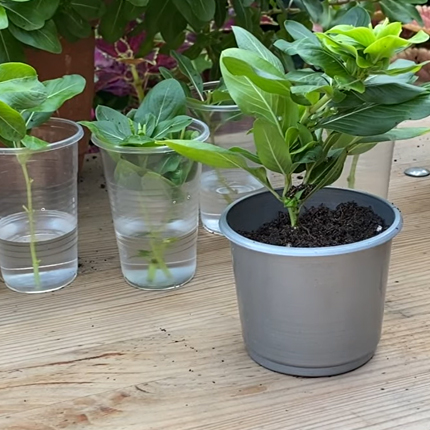
In spring and summer, it is very easy to achieve the germination of cuttings, but this is almost impossible in autumn. The fans of beautiful compositions are often not enthusiastic about propagation by cuttings. The fact is that after digging from a flower bed, the plant often loses its decorative effect and does not look aesthetically pleasing. If the plant bloomed outdoors, in a container or on a loggia, it will lose most of its foliage when moved into the house.
Upon transferring to the house, the cuttings adapt and become decorative again after about 1-2 weeks. You can add a little nitrogen fertilizer to speed up the process. It is not necessary to use parts of the plant that have managed to lignify, as they are unsuitable for reproduction. Choose only green cuttings, about 10 cm (~3.9 in.) long. Using apical cuttings exclusively is not required; any long parts of the plant will do, which are then cut into several pieces. The lower cut is made oblique and at a distance of approximately 5 mm (~0.2 in.) from the internode. All leaves are carefully cut, except for the top one-two. Be sure to pinch off the growth point, otherwise only leaves will form, and not the root system. After that, the cuttings are laid out on paper or gauze, in a well-ventilated area, as far as possible from the window. The cut sites are treated with activated charcoal or callus.
Reproduction of the cuttings at home is possible in water or by rooting directly into the open ground. The first method is more suitable for those who want to get a lot of new plants at a time, and the second is for growing them at home.
- Rooting cuttings in water. Cuttings with dried sections are placed in a container with filtered or settled water. Experts advise choosing glass containers, not plastic ones. The roots rot less often in glass and do not suffer from the harmful fauna. Growth stimulant and activated charcoal can be added to the water. This will help form roots faster and disinfect the environment. Then the cuttings are covered with a plastic bag and placed in a well-lit place. Every day it is necessary to give the seedlings a breath of fresh air. This will help stop the fungus formation and speed up the adaptation process. At a temperature of +20-22°C (68-71.6°F), the first roots should appear in 1.5 weeks. After that, the cuttings are planted in plastic glasses with holes for the water outflow. When the roots get used to the environment, they are transferred to a pot or into the open ground.
- Rooting cuttings in the ground. Many people prefer to cut the catharanthus immediately into small cups. The main secret of proper planting is the location of the petioles on the surface of the substrate. One internode should be completely in the soil, and the second at the surface level. A substrate for flowering plants is suitable – just add a little river sand to it. Rooting immediately in the open ground will not create any difficulties. With the onset of heat, the cuttings are simply planted in the soil and covered with a plastic bottle with a cut bottom. The bottle is removed immediately after full rooting.
Catharanthus Care
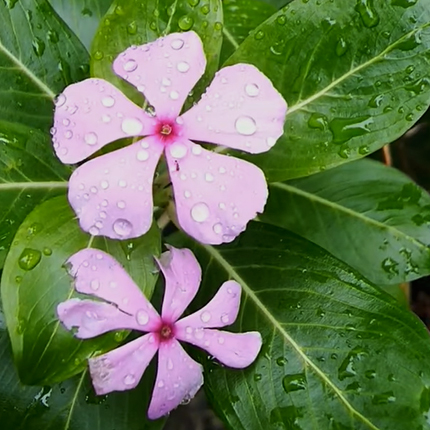
For abundant flowering, you need to follow a number of simple rules, and the catharanthus will thank you with its lush foliage and delicate leaves. Caring for a semi-shrub is similar to caring for geraniums, although it has its own characteristics. By analogy with the pelargonium, the tropical flower loves direct sunlight, but treats top dressing a little differently. Overall, the catharanthus is unpretentious, and many experts advise the beginners to use this particular plant in their first gardening experience. However, don’t forget about the extreme toxicity of the stem, leaves, and other parts. Always use gloves to avoid burns or an allergic reaction.
Watering and Humidity
The plant needs frequent and regular watering. High humidity is required for lush flowering both inside and outside the pot. When the indoor humidity is below 60%, you need to put a cup of water near the pot and regularly spray the catharanthus. Some precautions must be taken: while the foliage may respond well to moisture, the “drenched” flowers may begin to rot. Putting a pot with shrubs near heaters or air conditioners is not allowed, as the plant will die or lose all its decorative effect in a matter of days. It is better to put wet pebbles or expanded clay into the pan so as not to flood the roots and retain water for a longer period.
Poor or irregular watering will cause foliage to curl and fall off. Despite the plant’s love of water, stagnant moisture will lead to rotting roots. The substrate should be moist all the time, but no more. The drying of the top layer by 20-30 mm (~0.8-1.2 in.) is already a reason to water the catharanthus. Some grow the plant as a perennial, in which case watering should be reduced in autumn and spring. Domestic species have adapted well to the new conditions and arrange a “rest period” for themselves. If the humidity at home is low, then the plant should be sprayed all year round.
Lighting
The catharanthus needs good lighting, and the direct sunlight will not harm the flower in any way. The best choice is west- and east-facing windows. Slight shading is recommended with a curtain or tulle for the south-facing windows. The catharanthus grows not only near the window; you can put the pot in the center of the room, on the closet, or in another place. The main condition is that the sunrays must warm the shrub. In winter, the diffused sunlight shows itself better, which may be lacking in mid-latitudes. At the slightest sign of wilting, place artificial lighting lamps nearby. Without the light, the shoots will begin to stretch in search of the sun, and you can forget about the flowering.
Temperature
Indoor plants grow best at a temperature of +20-23°C (68-73.4°F), and the catharanthus is no exception. For the winter, the perennial is put in a cool place where the temperature will not exceed +15°C (59°F). The flower will survive the winter well on a warmed loggia. However, it will die in 5-7 days with prolonged exposure to the temperatures below +10°C (50°F). In summer, it is better to move the pot outside or put it on an open windowsill. The sunlight and nature will favorably affect the health of the shrub. This is especially useful if you are growing it as a perennial plant. Additionally, choose a place protected from draughts and precipitation. The catharanthus is transferred indoors with the beginning of autumn; there another flowering should begin, although not as plentiful as the first.
Soil Selection
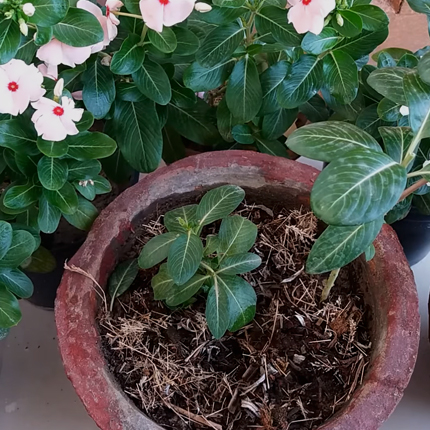
It is recommended to use a loose and well-drained substrate rich in nutrients and peat. A soil mixture for flowering plants or geraniums is fine, but it is better to make the soil yourself. You will need turf and leafy soil in equal proportions, as well as some peat. A thin layer of coarse river sand is added for drainage.
Pot Selection
When choosing a container, consider the volume and growth rate of the catharanthus. This flower belongs to the fast-growing category, quickly filling all the free space. A large container is suitable, in which the plant can develop well for a whole year. When growing perennials, the choice of pot should be approached with particular care. Do not forget to lay pebbles or expanded clay on the bottom in a thin layer (30-40 mm / ~1.2-1.6 in.). After that, the drainage is rammed from above with garden soil mixed with humus. This is done to increase the fertility of the soil. Transplantation is carried out every year, while the new container should be 30-40 mm (~1.2-1.6 in.) wider than the old one.
Top Dressing

The plant must be regularly fed for lush flowering. Annuals need supplements every week; even the richest substrate will not satisfy all the requirements of a catharanthus. Most often, liquid additives are used, which are diluted in water before usage. For example, the liquid fertilizer for indoor roses or geraniums is suitable. The dosage on the package is considered correct; it is not necessary to overfeed the shrub, otherwise this will affect the roots. The situation is more complicated with perennials. Top dressing should be dosed so that the plant retains strength for the next season and calmly goes through the winter. The perennial catharanthus is fertilized every 2 weeks, while the dosage should be half of that indicated on the package. In spring and autumn, additives are reduced to a minimum, and in winter, they do not feed the shrub at all. Perennials go without fertilizers from October to February.
Pruning
Catharanthus is characterized by rapid growth, so a shrub is formed quite often. In perennials, all elongated stems are shortened by about a third immediately after wintering. Dry, diseased, and withered stems are cut all year round, as part of sanitary pruning. The formation of a shrub in early spring allows you to extend the life of the plant and has a rejuvenating effect. The tops of the semi-shrub are regularly pinched to increase the decorative effect. Pinching inhibits growth in the wrong direction and stimulates the development of side shoots. Lateral branches make the shrub spectacular and lush. Pruning should be carried out constantly during flowering, as soon as the shrub begins to lose its decorative effect. Remove the yellow foliage and wilted flowers, as the plant is only wasting energy on maintaining useless offshoots.
Transplanting
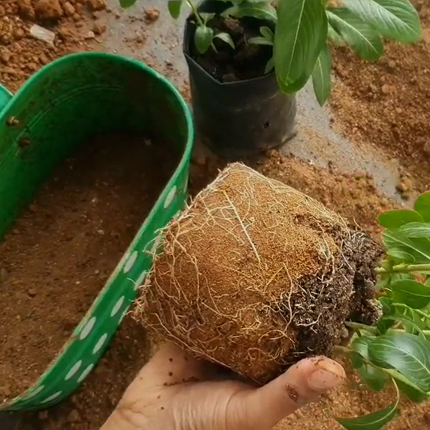
As mentioned above, the perennial catharanthus needs annual transplanting. If the growth is adequate, then the root system will constantly outgrow the pot in which it is located. Transplanting hippeastrum, catharanthus, and other tropical perennials contributes to the speedy budding. It is carried out in March, when the shrub has already managed to gain enough strength and is ready for a change. After transplantation, the catharanthus is transferred to a well-lit place. Next, you need to conduct an initial inspection and trimming. The shrub is transplanted carefully, by transshipment with an earthen clod. Try not to harm the root system and pay attention to the empty spaces in the new pot: they need to be filled with last year’s substrate, to which the plant is accustomed. A new substrate will not work, as such stress can lead to a lack of flowering in the new season. Use the same potting mix every year, for example, one for the flowering plants.
Sometimes the catharanthus has to be transplanted two times a year. When you see yellowed foliage, wilted flowers, and an elongated stem, this is a signal that the roots have already rested against the boundaries of the container. Check the drainage holes at the bottom of the pot, and if there are roots peeking out from there, then it’s time to transplant. To make this easy, it is better to water the plant 2-3 hours before the procedure. You can also simply break the plastic container in order to preserve the integrity of the earthen clod. Try not to damage the roots while doing this, however.
Pests and Diseases
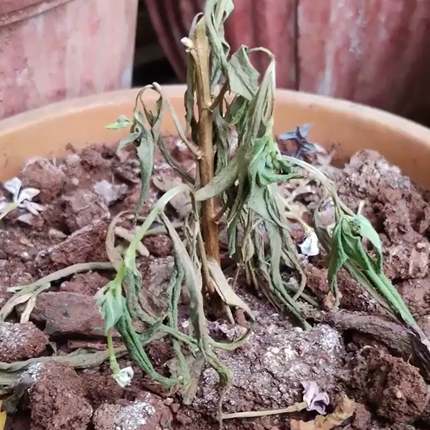
The diseases and pests can be judged based on the appearance of the plant. The catharanthus immediately signals its problems and the improper care on the part of the owner. Most problems arise from improper lighting, poor watering, or poor quality substrate. It is worth highlighting the several diseases which are especially dangerous for the evergreen shrub.
- Small spots on the front plate. Very often, something that looks like pustules appears on the wrong side. Such symptoms indicate that your catharanthus is sick with leaf rust. Most often, the development of such a disease occurs due to increased humidity, as well as regular waterlogging of the soil. It also happens that the catharanthus is planted in a substrate that is infected with rust fungi or is excessively heavy. In order to save the flower, it is treated with fungicidal solutions. After processing, the shrub is recommended to be transplanted into a fresh soil mixture.
- Yellow and sluggish foliage that constantly falls off. This can happen if the shrub is placed on the window but not protected from the scorching sunrays. In this case, the plant must be moved deep into the room, or it can be protected from the sun with the help of light curtains or blinds.
- Leaf plates turn yellow due to dry air. Such a problem especially often occurs in winter, since the air during this period is dried out by working heating devices. If this is the case, take a high pallet and fill it with wet expanded clay; also move the flower away from heating appliances. In addition, you can put an open vessel filled with water near it. If the shrub has already faded, then its foliage can be moistened with a spray gun using well-settled water, the temperature of which should be close to room temperature. As a result, the level of air humidity will increase, and the plant will return to normal.
- The lower leaf plates turn yellow and fall off. It’s a pretty natural process; if you carry out the sanitary pruning in time, then the flower’s decorative effect will not be disrupted, and you will have a beautiful and healthy plant.
- The catharanthus blooms poorly. This may be due to the fact that the room temperature is extremely low. Move the flower to a well-lit and warm place, and the problem will be solved.
- Flowering stops completely, the leaves turn yellow. Conduct a superficial inspection of the substrate: if roots stick out of the drainage holes at the bottom, this means that the shrub is pressed for space in the old container and needs to be transplanted into a new, more spacious one. After a while, it will return to normal and bloom again.
- Buds often lose petals. Most often, the reason lies in insufficient watering or poor lighting. Young leaves from the upper stems fall off in low light or cold.
Among the pests, the most dangerous are scale insects, spider mites, and aphids. These traditional parasites of the temperate continental climate are not averse to feasting on leaf plates and stem juices. They can easily get on the plant from the street, open loggia, or other plants nearby. It is necessary to constantly check the catharanthus and inspect the stems. The experts recommend washing the plant in a warm shower or soapy water when infected. This often helps against aphids and spider mites. In severe cases, you can resort to fungicides or insecticides; the suitable ones are Aktara, Fitoverm, and Aktellik. The pests will not die after one spraying, so the procedure must be repeated at least 3 times with an interval of 1 week. Carefully read the instructions on the package, as strong chemicals are hardly less harmful than spider mites. Remember that if you follow all the rules for care, the plant will delight you with lush flowering almost all year round.
